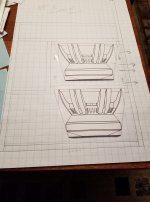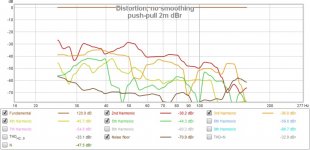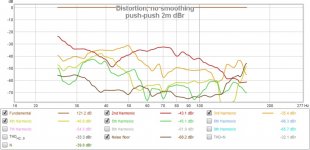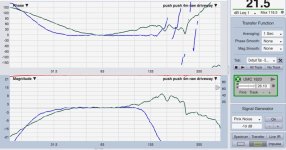Speaking of "still clueless:"
As far as 12" drivers, I've narrowed the search down to just a few. My primary concern is efficiency / sensitivity, but trying to use something of high quality at the same time.
Weight is another important consideration.
For anyone else looking to build a dual 12” PPSL, and slightly less clueless than me, here are my current top contenders. Any thoughts?
=========================================
### 18 Sound 12NLW9300 $350
800W RMS
Sensitivity: 97 dB
45 - 3,200 Hz
Resonant Frequency (Fs) 40 Hz
13.7 lbs (neo) !!!!!!!
notes:
Demodulaton rings.
Weather-resistant, reinforced cone.
I’d LOVE to use this one, but can I tune a dual 12” PPSL, BR box to ~ 38 Hz with good results?
——————————————————————————————
B&C 12BG100 $322
RMS: 1,000W
Sensitivity: 93 dB
40 - 1000 Hz
Fs 39 Hz
18 lbs
recommended tuning: 40 Hz
notes:
Demodulaton rings.
Ventilated voice coil gap.
Waterproof cone.
—————————————————————————————
Faital Pro 12PR320
300 W
Sensitivity: 97 dB
45 - 5000 Hz
Fs: 42 Hz
6.1 lbs !!!!!!!!
notes: No demodulaton rings. A fairly simple design. Probably the only reason to choose this over the 18 Sound is weight.
——————————————————————————————
Aurum Cantus AC300/75C2C $259
250w rms
Sensitivity: 91 dB
22 to 2,800 Hz
Fs: 22 Hz
18 lbs
notes: Can’t take a lot of power, but probably the “best” lightweight 12” with a really low Fs.
As far as 12" drivers, I've narrowed the search down to just a few. My primary concern is efficiency / sensitivity, but trying to use something of high quality at the same time.
Weight is another important consideration.
For anyone else looking to build a dual 12” PPSL, and slightly less clueless than me, here are my current top contenders. Any thoughts?
=========================================
### 18 Sound 12NLW9300 $350
800W RMS
Sensitivity: 97 dB
45 - 3,200 Hz
Resonant Frequency (Fs) 40 Hz
13.7 lbs (neo) !!!!!!!
notes:
Demodulaton rings.
Weather-resistant, reinforced cone.
I’d LOVE to use this one, but can I tune a dual 12” PPSL, BR box to ~ 38 Hz with good results?
——————————————————————————————
B&C 12BG100 $322
RMS: 1,000W
Sensitivity: 93 dB
40 - 1000 Hz
Fs 39 Hz
18 lbs
recommended tuning: 40 Hz
notes:
Demodulaton rings.
Ventilated voice coil gap.
Waterproof cone.
—————————————————————————————
Faital Pro 12PR320
300 W
Sensitivity: 97 dB
45 - 5000 Hz
Fs: 42 Hz
6.1 lbs !!!!!!!!
notes: No demodulaton rings. A fairly simple design. Probably the only reason to choose this over the 18 Sound is weight.
——————————————————————————————
Aurum Cantus AC300/75C2C $259
250w rms
Sensitivity: 91 dB
22 to 2,800 Hz
Fs: 22 Hz
18 lbs
notes: Can’t take a lot of power, but probably the “best” lightweight 12” with a really low Fs.
Last edited:
And I have to ask, because it'smaking me a bit looney at thispoint:
B&C 12NBX100
full specs: B&C Speakers
Sensitivity: 96 dB
RMS: 1,000W
40 - 1500 Hz
Fs 41 Hz
17.6 lbs
This driver is looking SO good to me at this point (dat sensitivity!) - until I read:
" recommended tuning: 50 Hz"
Huh? How can that be, given the frequency range, the Fs, and the high power handling?
What am I missing?
B&C 12NBX100
full specs: B&C Speakers
Sensitivity: 96 dB
RMS: 1,000W
40 - 1500 Hz
Fs 41 Hz
17.6 lbs
This driver is looking SO good to me at this point (dat sensitivity!) - until I read:
" recommended tuning: 50 Hz"
Huh? How can that be, given the frequency range, the Fs, and the high power handling?
What am I missing?
1) The relatively small PPSL plenum allows for a close driver arrangement, more effective for even order harmonic distortion reduction, and also provides force cancellation.1)Which is more effective as a LPF, for the distortions we want to minimize, a horn or a PPSL plenum
2)You seem to be saying the plenum, which makes sense based on some glowing PPSL opinions (And once again why I'm not looking at a horn, at the moment.)
3)So then the really big question is, how to determine the ideal plenum size, in terms of filtering the odd order harmonics?
4)One consideration of plenum size is HF extension, but I'm looking for a "standard" subwoofer, crossing over at about 100 Hz.
5)Another consideration is compression, though the general thought seems to be "it looks small, but probably isn't a problem."
6)But what about those harmonics? (And high frequency modulation noise, while we're at it.) 7)Should I not be trying to make the plenum limit as close to 100 Hz as possible?
8)- And if so, how does one calculate that?
9)I'm obviously still mostly clueless on this.
2) Both a plenum or a horn provide some degree of acoustic low-pass filter, a different function from the even order harmonic distortion reduction the reversed polarity/reversed driver provides.
3) Again, the plenum does little in terms of "filtering the odd (or even) order harmonics.
4) The plenum does not extend upper response, it results in an upper response peak, a "pipe resonance" depending on volume, depth, and the driver configuration inside it.
5) Yeah, not a problem with push-pull, make it small as possible.
6) I don't understand the question.
PPSL has not been demonstrated to do anything regarding IMD, AFAIK.
7) What is a "plenum limit" ?
8) Hornresp is probably the simplest program to use that can model both BR and the plenum.
The "Wizard" function makes it easy to see the frequency response results of making ports, plenums and rear chambers bigger or smaller by just moving a bar (button, slider, thingie..) left or right.
9) If you start to model the designs you are interested in, some of the concepts will become more clear.
^ Thanks a TON for the clarification.
And now I feel like I'm fighting a guy who's given me an great amount of time & advice but:
I understand the first part, but of course with a "standard" sub being crossed at maybe 100Hz, a small difference in closeness is not likely to matter, regarding audible even order harmonics. No?
--------
You should have a discussion with Wayne Parham.
Ina 2006 article entitled "Push-pull versus shorting rings," he wrote:
"Push-pull drive is particularly attractive when used in a horn subwoofer:
Push-pull drive only reduces the second harmonic.
A horn’s front chamber and mass-rolloff tend to reduce third and higher harmonics. This in addition to the already low distortion due to reduced excursion from horn loading. Horn subwoofers with push-pull drive offer excellent low-distortion performance even at very high power levels."
His words, not mine. I'm personally still clueless.....
As for #6, what don't you understand. When the plenum rolls off the HF, it rolls of the harmonic distortion artifacts. That all I keep referring to. (Though I must remember to not inaccurately use the word "negate" !! )
)
---------------------------------------------------
BTW, I recently read somewhere that another advantage of the plenum, vs a simple push-pull design, is that it causes both drivers to act more as one unit, with better phase coherence, or something. Would you agree with this?
And now I feel like I'm fighting a guy who's given me an great amount of time & advice but:
1) The relatively small PPSL plenum allows for a close driver arrangement, more effective for even order harmonic distortion reduction, and also provides force cancellation.
I understand the first part, but of course with a "standard" sub being crossed at maybe 100Hz, a small difference in closeness is not likely to matter, regarding audible even order harmonics. No?
--------
1)
3) Again, the plenum does little in terms of "filtering the odd (or even) order harmonics.
6) I don't understand the question. .
You should have a discussion with Wayne Parham.
Ina 2006 article entitled "Push-pull versus shorting rings," he wrote:
"Push-pull drive is particularly attractive when used in a horn subwoofer:
Push-pull drive only reduces the second harmonic.
A horn’s front chamber and mass-rolloff tend to reduce third and higher harmonics. This in addition to the already low distortion due to reduced excursion from horn loading. Horn subwoofers with push-pull drive offer excellent low-distortion performance even at very high power levels."
His words, not mine. I'm personally still clueless.....
As for #6, what don't you understand. When the plenum rolls off the HF, it rolls of the harmonic distortion artifacts. That all I keep referring to. (Though I must remember to not inaccurately use the word "negate" !!
---------------------------------------------------
BTW, I recently read somewhere that another advantage of the plenum, vs a simple push-pull design, is that it causes both drivers to act more as one unit, with better phase coherence, or something. Would you agree with this?
8) Hornresp is probably the simplest program to use that can model both BR and the plenum. The "Wizard" function makes it easy to see the frequency response results of making ports, plenums and rear chambers bigger or smaller by just moving a bar (button, slider, thingie..) left or right.
9) If you start to model the designs you are interested in, some of the concepts will become more clear.
I'm getting close.
THANKS !
Speaking of "still clueless:"
As far as 12" drivers, I've narrowed the search down to just a few. My primary concern is efficiency / sensitivity, but trying to use something of high quality at the same time.
Weight is another important consideration.
For anyone else looking to build a dual 12” PPSL, and slightly less clueless than me, here are my current top contenders. Any thoughts?
=========================================
### 18 Sound 12NLW9300 $350
800W RMS
Sensitivity: 97 dB
45 - 3,200 Hz
Resonant Frequency (Fs) 40 Hz
13.7 lbs (neo) !!!!!!!
notes:
Demodulaton rings.
Weather-resistant, reinforced cone.
I’d LOVE to use this one, but can I tune a dual 12” PPSL, BR box to ~ 38 Hz with good results?
——————————————————————————————
B&C 12BG100 $322
RMS: 1,000W
Sensitivity: 93 dB
40 - 1000 Hz
Fs 39 Hz
18 lbs
recommended tuning: 40 Hz
notes:
Demodulaton rings.
Ventilated voice coil gap.
Waterproof cone.
—————————————————————————————
Faital Pro 12PR320
300 W
Sensitivity: 97 dB
45 - 5000 Hz
Fs: 42 Hz
6.1 lbs !!!!!!!!
notes: No demodulaton rings. A fairly simple design. Probably the only reason to choose this over the 18 Sound is weight.
——————————————————————————————
Aurum Cantus AC300/75C2C $259
250w rms
Sensitivity: 91 dB
22 to 2,800 Hz
Fs: 22 Hz
18 lbs
notes: Can’t take a lot of power, but probably the “best” lightweight 12” with a really low Fs.
My choice to try to make a PPSL with Creative Sound Solutions | High End Speakers and Speaker Kits was probably not the best choice, they weigh a ton and are huge...
Think it could work, or am I wasting my time?
1) No thanks, been there, done that, we were sent to the "sin bin" in late July of 2011 for our "discussion" regarding various aspects of PP and acoustic centers1)You should have a discussion with Wayne Parham.
2)BTW, I recently read somewhere that another advantage of the plenum, vs a simple push-pull design, is that it causes both drivers to act more as one unit, with better phase coherence, or something. Would you agree with this?
 .
. 2) Not enough difference one way or another to agree or disagree with those items.
The force cancellation of opposing drivers will keep the cabinet from walking, which is cool.
Compare the drivers back vent noise to the tiny amount of even order distortion the driver will produce at 2" peak to peak travel, decide which is more objectionable for your application.My choice to try to make a PPSL with Creative Sound Solutions | High End Speakers and Speaker Kits was probably not the best choice, they weigh a ton and are huge...
Think it could work, or am I wasting my time?
In the case of use as a home theatre sub, would downfiring into a suitably thick rug or carpet reduce/remove any higher frequency back vent noise or suspension noise?Compare the drivers back vent noise to the tiny amount of even order distortion the driver will produce at 2" peak to peak travel, decide which is more objectionable for your application.
I imagine that in a lot of films, if the sub is working at XMax, the mains will probably also be very loud and masking vent noise! lol
Perhaps the photo below will help explain- the push-push plenum exit dimension is only 3/4" x 10.25". This dimension caused no audible "chuffing" or cone problems.
Art, my mellon is having a hard time undertanding chuffing.....
In your picture, how can so much cone area relative to the plenum exit not chuff,
when we need so much port area relative to SD to keep ports from chuffing?
Same question I guess...but how do synergies not chuff?
1) Down-firing will result in cone sag eventually.1)In the case of use as a home theatre sub, would downfiring into a suitably thick rug or carpet reduce/remove any higher frequency back vent noise or suspension noise?
2)I imagine that in a lot of films, if the sub is working at XMax, the mains will probably also be very loud and masking vent noise! lol
A thick rug might be enough to reduce back vent noise but would do little to reduce suspension noise, which is "horn loaded" by the cone and spider.
2) Most of the time, yes, other times there are special sub effects with very little HF. Since the vent noise comes from a different location from the mains, a little can go a long way- like the jerk that whispers all through the movie at the theater..
Bumblebees shouldn't be able to fly ;^)...Art, my mellon is having a hard time undertanding chuffing.....
In your picture, how can so much cone area relative to the plenum exit not chuff,
when we need so much port area relative to SD to keep ports from chuffing?
Same question I guess...but how do synergies not chuff?
As a guess, perhaps it's the difference between the narrow Helmholtz resonance (180 degree lag) and the direct coupled acoustic low pass filter output of a small plenum throat volume (ATC).
You might also check port velocities of either in Hornresp and compare.
That said, I think rounding port corners goes a long way in reducing wind noise (chuffing) so velocity only does not determine audibility.
Last edited:
Bumblebees shouldn't be able to fly ;^)...
As a guess, perhaps it's the difference between the narrow Helmholtz resonance (180 degree lag) and the direct coupled acoustic low pass filter output of a small plenum throat volume (ATC).
You might also check port velocities of either in Hornresp and compare.
That said, I think rounding port corners goes a long way in reducing wind noise (chuffing) so velocity only does not determine audibility.
I've been meaning to thank you for this reply as i keep mulling it over....
On the PPSL I'm playing with, listening to wind noise from the port, and hearing none from the plenum....well, how do bumblebees fly

Just look at a box modeling simulation. Velocity is high at the tuning frequency but on either side of that the velocity decreases rapidly. The plenum resonance is higher than the frequencies you'll be using it at.
Yes, thx. It's getting an intuitive understanding of resonance and velocity I'm after. I'm one of those blockheads that doesn't get it, until it seems simple....
Been listening to the double 18" PPSL for a week or so, both in push-pull configuration, and also turning the inverted driver around into a push-push clamshell.
Both have sounded great, sounding just like the single 18" BR that served as the model.
Weather finally allowed a nice day of testing ......
Since the whole idea of push-pull is 2nd order harmonic distortion reduction,
I decided to test push-pull inverted, vs push-push (clamshell).
I mean, why not just make a direct comparison using the same box, right ?!
I used REW's stepped-sine harmonic distortion routine.
First plot is push-pull.
Second is push-push.
Both were at 2 meters, so add 6dB to SPL.
I don't see a clear distortion case for either.................??
And I haven't really heard anything in listening tests either.
However, the suspension and coil vent noise below 35Hz, was much louder with the pull driver exposed in the plenum, than when the driver rests in the cabinet as a push driver.
So, I'm going with push-push.
This gives the vibration reduction that I'm primarily after, and allows for a very easy periodic rotation of drivers to get over the horizontal sag stuff.
Having decided on push-push, I put together some processing.
Last plot is raw and then processed, mag and phase,
Raw is dark green. Processed is blue.
I was hoping to hear something substantially cleaner than I'm used to, from the PPSL. But just wasn't the case. Both sound very, very clean. Still very happy to have built this, if only for vibration reduction...
Both have sounded great, sounding just like the single 18" BR that served as the model.
Weather finally allowed a nice day of testing ......
Since the whole idea of push-pull is 2nd order harmonic distortion reduction,
I decided to test push-pull inverted, vs push-push (clamshell).
I mean, why not just make a direct comparison using the same box, right ?!
I used REW's stepped-sine harmonic distortion routine.
First plot is push-pull.
Second is push-push.
Both were at 2 meters, so add 6dB to SPL.
I don't see a clear distortion case for either.................??
And I haven't really heard anything in listening tests either.
However, the suspension and coil vent noise below 35Hz, was much louder with the pull driver exposed in the plenum, than when the driver rests in the cabinet as a push driver.
So, I'm going with push-push.
This gives the vibration reduction that I'm primarily after, and allows for a very easy periodic rotation of drivers to get over the horizontal sag stuff.
Having decided on push-push, I put together some processing.
Last plot is raw and then processed, mag and phase,
Raw is dark green. Processed is blue.
I was hoping to hear something substantially cleaner than I'm used to, from the PPSL. But just wasn't the case. Both sound very, very clean. Still very happy to have built this, if only for vibration reduction...
Attachments
Last edited:
Been listening to the double 18" PPSL for a week or so, both in push-pull configuration, and also turning the inverted driver around into a push-push clamshell. <snip>
Why are these tests showing the fundamental response being RULER FLAT ?
- Status
- This old topic is closed. If you want to reopen this topic, contact a moderator using the "Report Post" button.
- Home
- Loudspeakers
- Subwoofers
- A Thread for those interested in PPSL enclosures



